Environmental Risk Assessment: Skin Cancer Risk for Outdoor Workers
VerifiedAdded on 2023/06/03
|10
|2357
|118
Report
AI Summary
This report presents an environmental risk assessment of skin cancer among outdoor workers, focusing on a case study conducted in Queensland, Australia. It examines the methodology used, which involved a mixed-methods approach, and the data collected through interviews, discussion groups, and surveys. The report details the data analysis process and the interventions implemented, such as the introduction of sun safety policies, provision of protective equipment, and educational programs. It highlights the results achieved, including the adoption of shade structures and sunscreen dispensers. Furthermore, the report discusses the limitations of the assessment, such as the small sample size and potential literacy barriers, and offers recommendations for improving risk management strategies. The conclusion emphasizes the importance of proactive measures to mitigate the risk of skin cancer in outdoor workplaces, underscoring the need for comprehensive policies, worker engagement, and funding for effective sun safety initiatives. The document is contributed by a student to be published on the website Desklib, a platform which provides all the necessary AI based study tools for students.
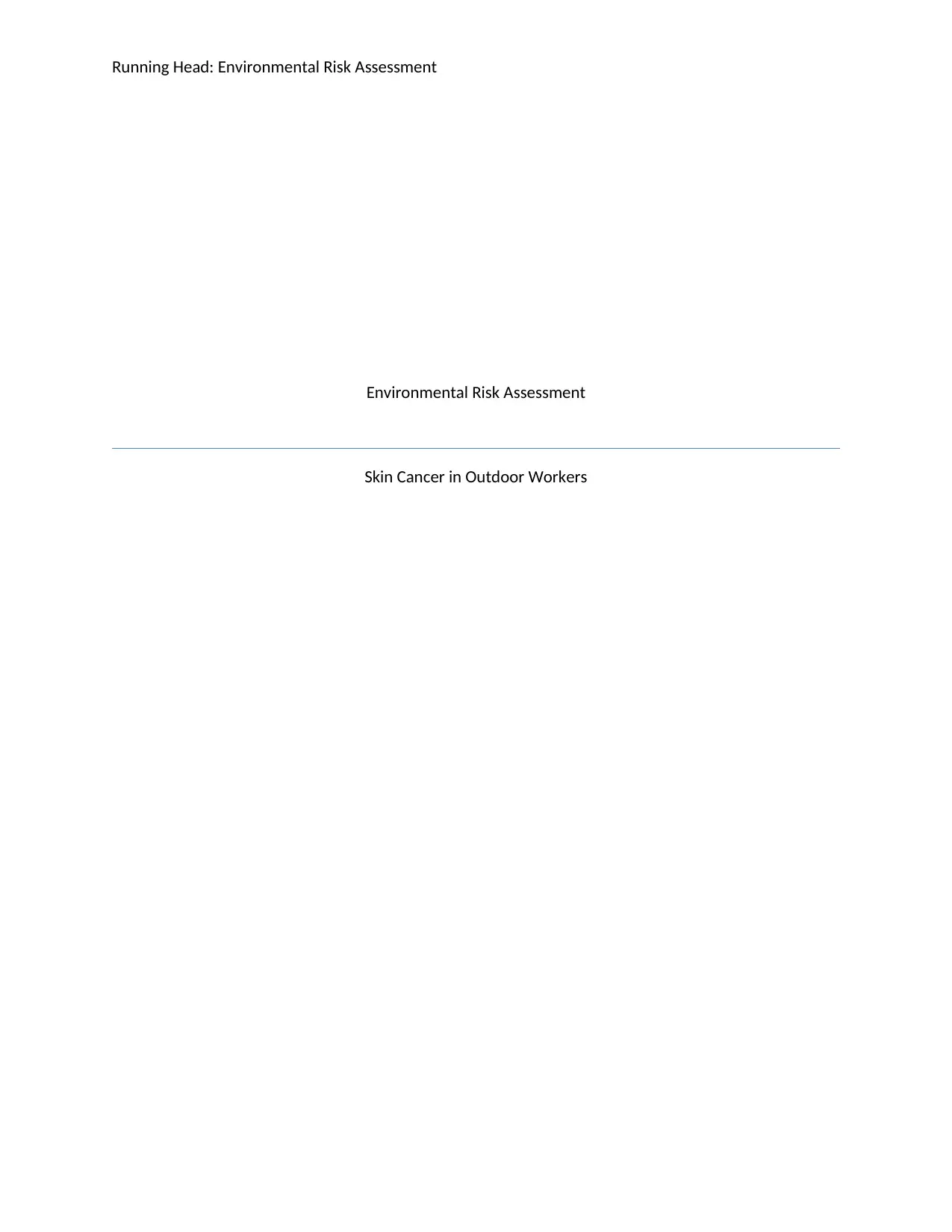
Running Head: Environmental Risk Assessment
Environmental Risk Assessment
Skin Cancer in Outdoor Workers
Environmental Risk Assessment
Skin Cancer in Outdoor Workers
Paraphrase This Document
Need a fresh take? Get an instant paraphrase of this document with our AI Paraphraser
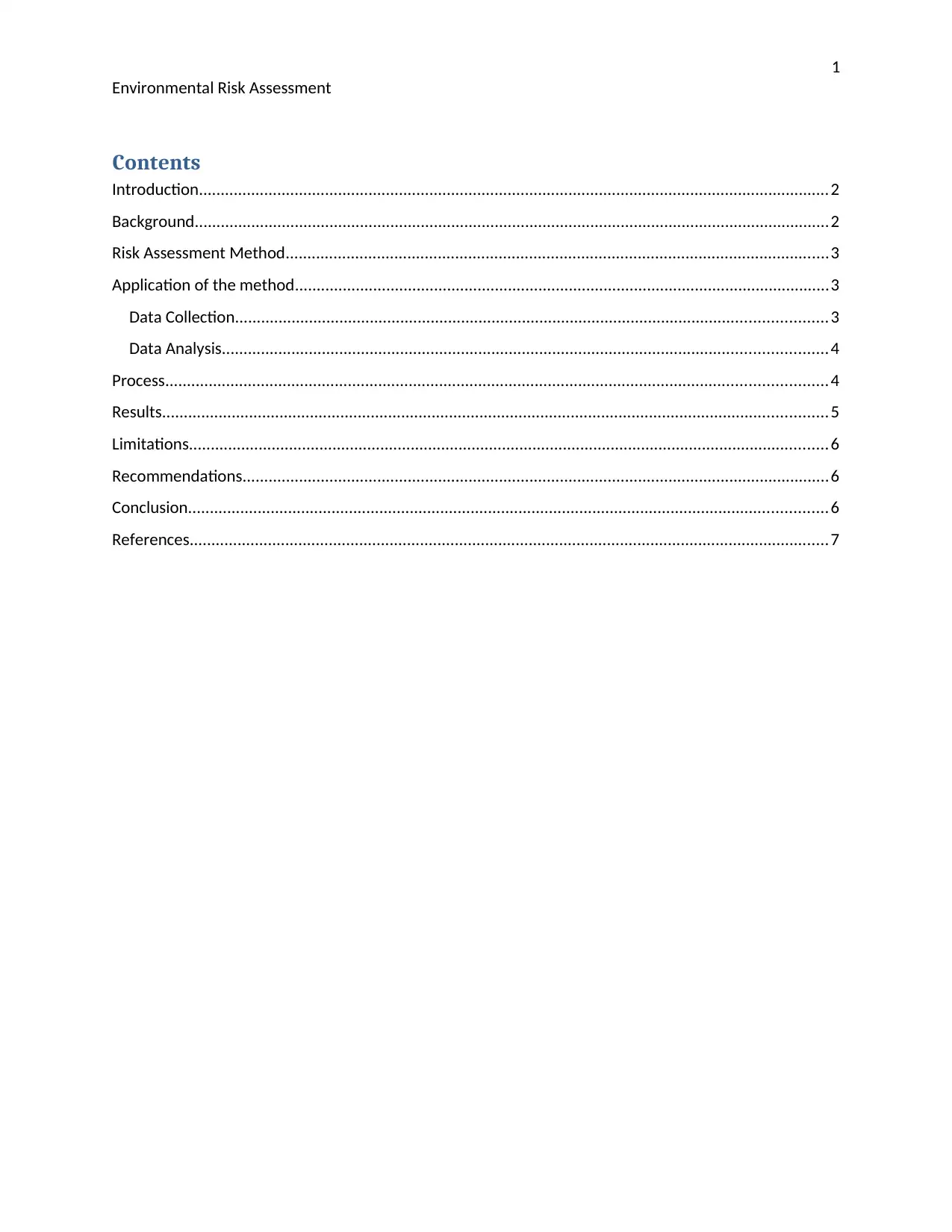
1
Environmental Risk Assessment
Contents
Introduction.................................................................................................................................................2
Background..................................................................................................................................................2
Risk Assessment Method.............................................................................................................................3
Application of the method...........................................................................................................................3
Data Collection........................................................................................................................................3
Data Analysis...........................................................................................................................................4
Process........................................................................................................................................................4
Results.........................................................................................................................................................5
Limitations...................................................................................................................................................6
Recommendations.......................................................................................................................................6
Conclusion...................................................................................................................................................6
References...................................................................................................................................................7
Environmental Risk Assessment
Contents
Introduction.................................................................................................................................................2
Background..................................................................................................................................................2
Risk Assessment Method.............................................................................................................................3
Application of the method...........................................................................................................................3
Data Collection........................................................................................................................................3
Data Analysis...........................................................................................................................................4
Process........................................................................................................................................................4
Results.........................................................................................................................................................5
Limitations...................................................................................................................................................6
Recommendations.......................................................................................................................................6
Conclusion...................................................................................................................................................6
References...................................................................................................................................................7
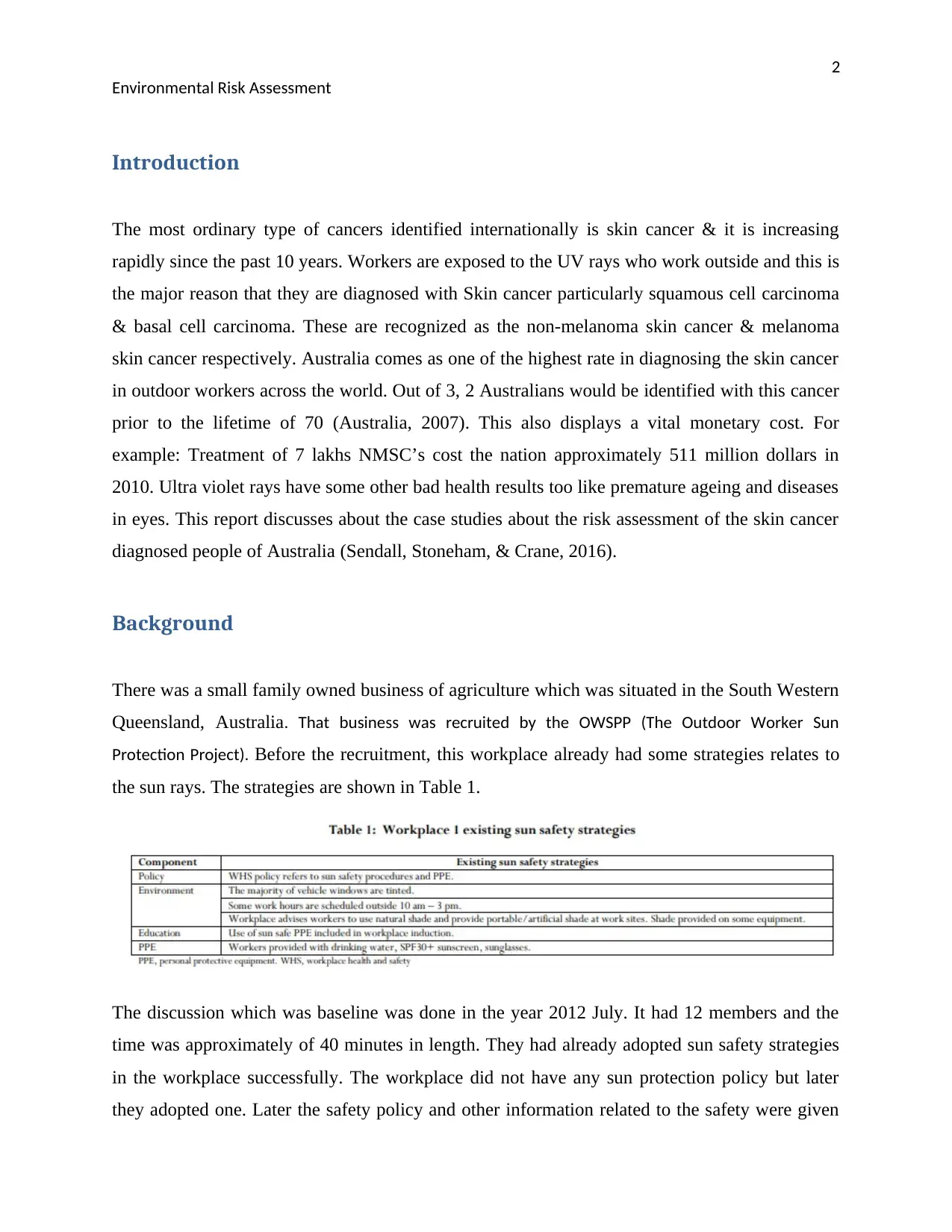
2
Environmental Risk Assessment
Introduction
The most ordinary type of cancers identified internationally is skin cancer & it is increasing
rapidly since the past 10 years. Workers are exposed to the UV rays who work outside and this is
the major reason that they are diagnosed with Skin cancer particularly squamous cell carcinoma
& basal cell carcinoma. These are recognized as the non-melanoma skin cancer & melanoma
skin cancer respectively. Australia comes as one of the highest rate in diagnosing the skin cancer
in outdoor workers across the world. Out of 3, 2 Australians would be identified with this cancer
prior to the lifetime of 70 (Australia, 2007). This also displays a vital monetary cost. For
example: Treatment of 7 lakhs NMSC’s cost the nation approximately 511 million dollars in
2010. Ultra violet rays have some other bad health results too like premature ageing and diseases
in eyes. This report discusses about the case studies about the risk assessment of the skin cancer
diagnosed people of Australia (Sendall, Stoneham, & Crane, 2016).
Background
There was a small family owned business of agriculture which was situated in the South Western
Queensland, Australia. That business was recruited by the OWSPP (The Outdoor Worker Sun
Protection Project). Before the recruitment, this workplace already had some strategies relates to
the sun rays. The strategies are shown in Table 1.
The discussion which was baseline was done in the year 2012 July. It had 12 members and the
time was approximately of 40 minutes in length. They had already adopted sun safety strategies
in the workplace successfully. The workplace did not have any sun protection policy but later
they adopted one. Later the safety policy and other information related to the safety were given
Environmental Risk Assessment
Introduction
The most ordinary type of cancers identified internationally is skin cancer & it is increasing
rapidly since the past 10 years. Workers are exposed to the UV rays who work outside and this is
the major reason that they are diagnosed with Skin cancer particularly squamous cell carcinoma
& basal cell carcinoma. These are recognized as the non-melanoma skin cancer & melanoma
skin cancer respectively. Australia comes as one of the highest rate in diagnosing the skin cancer
in outdoor workers across the world. Out of 3, 2 Australians would be identified with this cancer
prior to the lifetime of 70 (Australia, 2007). This also displays a vital monetary cost. For
example: Treatment of 7 lakhs NMSC’s cost the nation approximately 511 million dollars in
2010. Ultra violet rays have some other bad health results too like premature ageing and diseases
in eyes. This report discusses about the case studies about the risk assessment of the skin cancer
diagnosed people of Australia (Sendall, Stoneham, & Crane, 2016).
Background
There was a small family owned business of agriculture which was situated in the South Western
Queensland, Australia. That business was recruited by the OWSPP (The Outdoor Worker Sun
Protection Project). Before the recruitment, this workplace already had some strategies relates to
the sun rays. The strategies are shown in Table 1.
The discussion which was baseline was done in the year 2012 July. It had 12 members and the
time was approximately of 40 minutes in length. They had already adopted sun safety strategies
in the workplace successfully. The workplace did not have any sun protection policy but later
they adopted one. Later the safety policy and other information related to the safety were given
⊘ This is a preview!⊘
Do you want full access?
Subscribe today to unlock all pages.

Trusted by 1+ million students worldwide
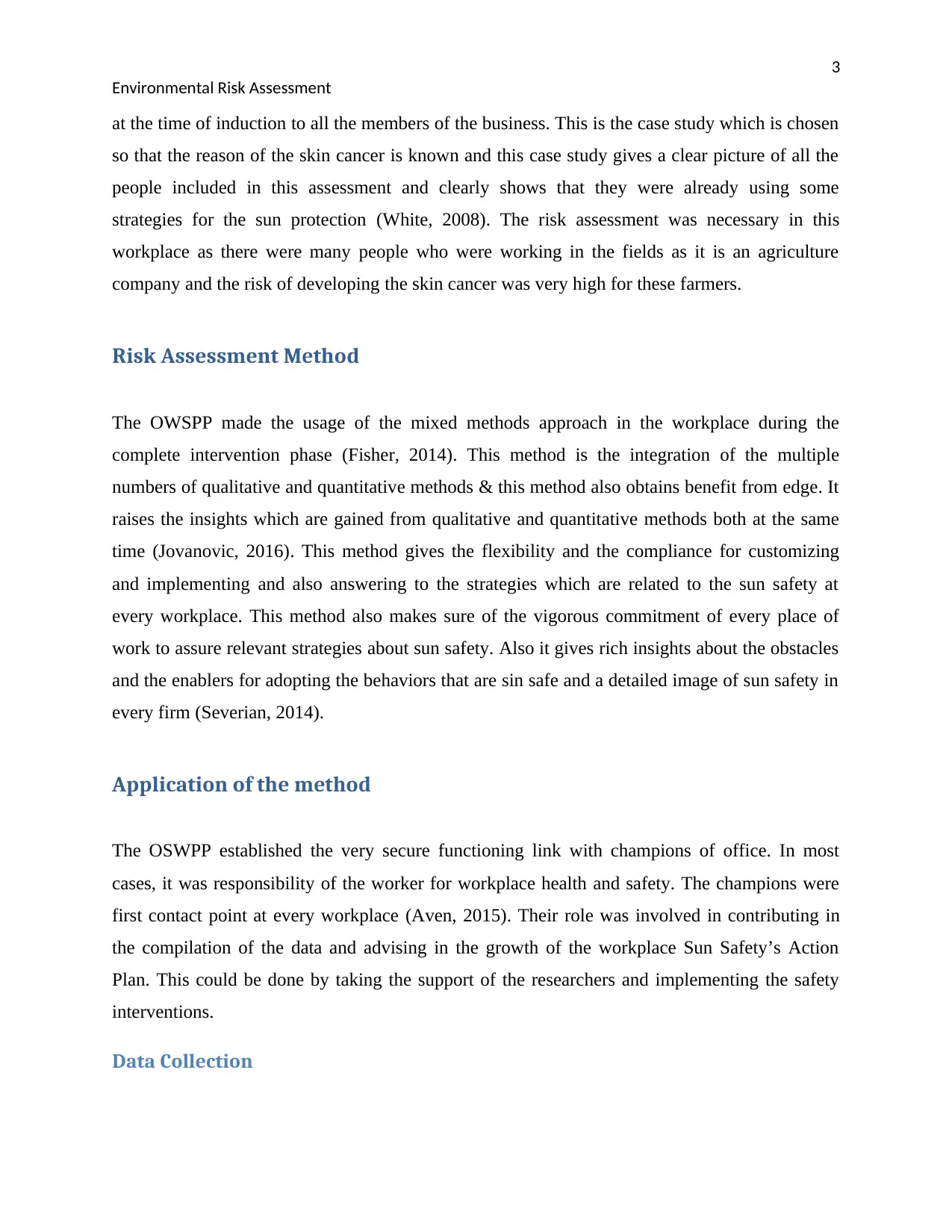
3
Environmental Risk Assessment
at the time of induction to all the members of the business. This is the case study which is chosen
so that the reason of the skin cancer is known and this case study gives a clear picture of all the
people included in this assessment and clearly shows that they were already using some
strategies for the sun protection (White, 2008). The risk assessment was necessary in this
workplace as there were many people who were working in the fields as it is an agriculture
company and the risk of developing the skin cancer was very high for these farmers.
Risk Assessment Method
The OWSPP made the usage of the mixed methods approach in the workplace during the
complete intervention phase (Fisher, 2014). This method is the integration of the multiple
numbers of qualitative and quantitative methods & this method also obtains benefit from edge. It
raises the insights which are gained from qualitative and quantitative methods both at the same
time (Jovanovic, 2016). This method gives the flexibility and the compliance for customizing
and implementing and also answering to the strategies which are related to the sun safety at
every workplace. This method also makes sure of the vigorous commitment of every place of
work to assure relevant strategies about sun safety. Also it gives rich insights about the obstacles
and the enablers for adopting the behaviors that are sin safe and a detailed image of sun safety in
every firm (Severian, 2014).
Application of the method
The OSWPP established the very secure functioning link with champions of office. In most
cases, it was responsibility of the worker for workplace health and safety. The champions were
first contact point at every workplace (Aven, 2015). Their role was involved in contributing in
the compilation of the data and advising in the growth of the workplace Sun Safety’s Action
Plan. This could be done by taking the support of the researchers and implementing the safety
interventions.
Data Collection
Environmental Risk Assessment
at the time of induction to all the members of the business. This is the case study which is chosen
so that the reason of the skin cancer is known and this case study gives a clear picture of all the
people included in this assessment and clearly shows that they were already using some
strategies for the sun protection (White, 2008). The risk assessment was necessary in this
workplace as there were many people who were working in the fields as it is an agriculture
company and the risk of developing the skin cancer was very high for these farmers.
Risk Assessment Method
The OWSPP made the usage of the mixed methods approach in the workplace during the
complete intervention phase (Fisher, 2014). This method is the integration of the multiple
numbers of qualitative and quantitative methods & this method also obtains benefit from edge. It
raises the insights which are gained from qualitative and quantitative methods both at the same
time (Jovanovic, 2016). This method gives the flexibility and the compliance for customizing
and implementing and also answering to the strategies which are related to the sun safety at
every workplace. This method also makes sure of the vigorous commitment of every place of
work to assure relevant strategies about sun safety. Also it gives rich insights about the obstacles
and the enablers for adopting the behaviors that are sin safe and a detailed image of sun safety in
every firm (Severian, 2014).
Application of the method
The OSWPP established the very secure functioning link with champions of office. In most
cases, it was responsibility of the worker for workplace health and safety. The champions were
first contact point at every workplace (Aven, 2015). Their role was involved in contributing in
the compilation of the data and advising in the growth of the workplace Sun Safety’s Action
Plan. This could be done by taking the support of the researchers and implementing the safety
interventions.
Data Collection
Paraphrase This Document
Need a fresh take? Get an instant paraphrase of this document with our AI Paraphraser
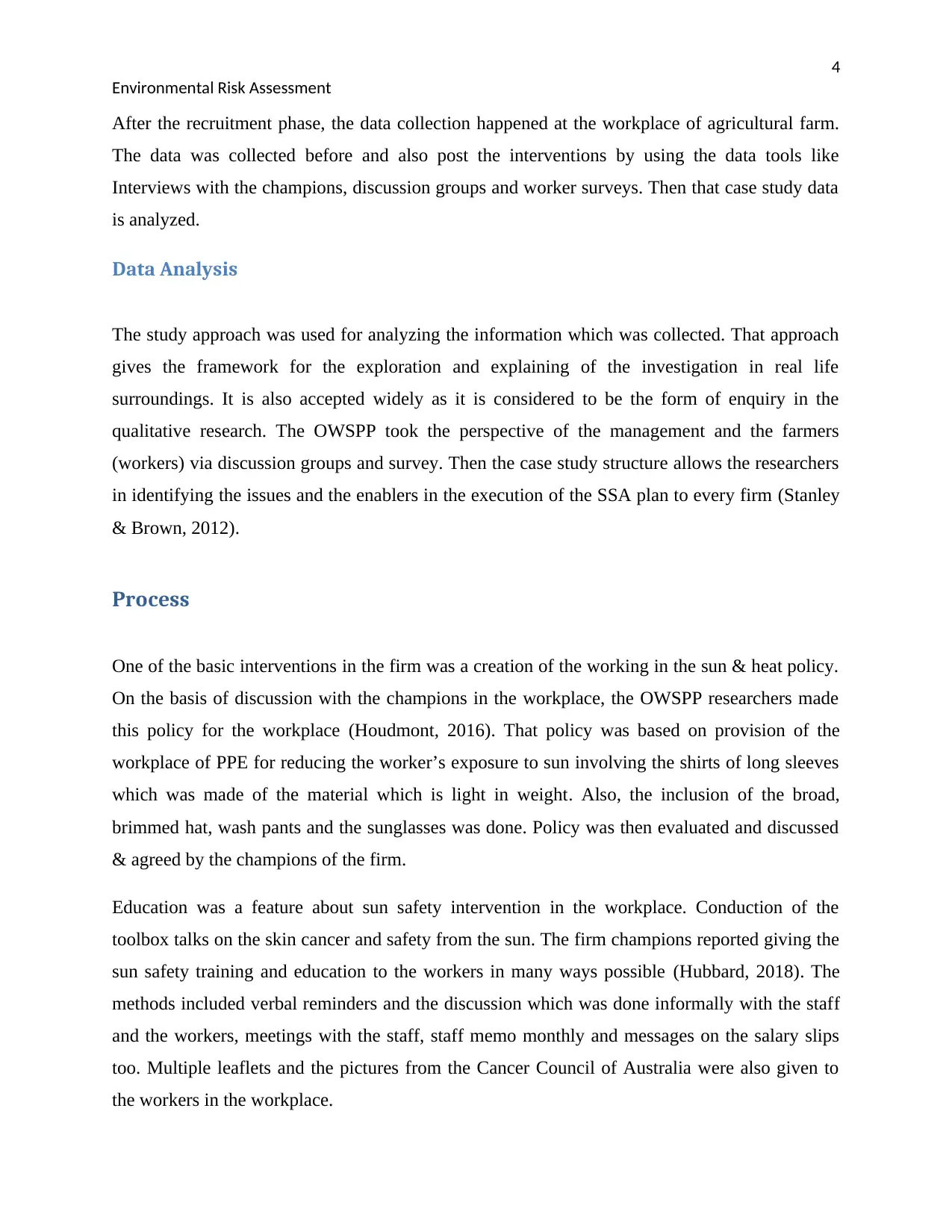
4
Environmental Risk Assessment
After the recruitment phase, the data collection happened at the workplace of agricultural farm.
The data was collected before and also post the interventions by using the data tools like
Interviews with the champions, discussion groups and worker surveys. Then that case study data
is analyzed.
Data Analysis
The study approach was used for analyzing the information which was collected. That approach
gives the framework for the exploration and explaining of the investigation in real life
surroundings. It is also accepted widely as it is considered to be the form of enquiry in the
qualitative research. The OWSPP took the perspective of the management and the farmers
(workers) via discussion groups and survey. Then the case study structure allows the researchers
in identifying the issues and the enablers in the execution of the SSA plan to every firm (Stanley
& Brown, 2012).
Process
One of the basic interventions in the firm was a creation of the working in the sun & heat policy.
On the basis of discussion with the champions in the workplace, the OWSPP researchers made
this policy for the workplace (Houdmont, 2016). That policy was based on provision of the
workplace of PPE for reducing the worker’s exposure to sun involving the shirts of long sleeves
which was made of the material which is light in weight. Also, the inclusion of the broad,
brimmed hat, wash pants and the sunglasses was done. Policy was then evaluated and discussed
& agreed by the champions of the firm.
Education was a feature about sun safety intervention in the workplace. Conduction of the
toolbox talks on the skin cancer and safety from the sun. The firm champions reported giving the
sun safety training and education to the workers in many ways possible (Hubbard, 2018). The
methods included verbal reminders and the discussion which was done informally with the staff
and the workers, meetings with the staff, staff memo monthly and messages on the salary slips
too. Multiple leaflets and the pictures from the Cancer Council of Australia were also given to
the workers in the workplace.
Environmental Risk Assessment
After the recruitment phase, the data collection happened at the workplace of agricultural farm.
The data was collected before and also post the interventions by using the data tools like
Interviews with the champions, discussion groups and worker surveys. Then that case study data
is analyzed.
Data Analysis
The study approach was used for analyzing the information which was collected. That approach
gives the framework for the exploration and explaining of the investigation in real life
surroundings. It is also accepted widely as it is considered to be the form of enquiry in the
qualitative research. The OWSPP took the perspective of the management and the farmers
(workers) via discussion groups and survey. Then the case study structure allows the researchers
in identifying the issues and the enablers in the execution of the SSA plan to every firm (Stanley
& Brown, 2012).
Process
One of the basic interventions in the firm was a creation of the working in the sun & heat policy.
On the basis of discussion with the champions in the workplace, the OWSPP researchers made
this policy for the workplace (Houdmont, 2016). That policy was based on provision of the
workplace of PPE for reducing the worker’s exposure to sun involving the shirts of long sleeves
which was made of the material which is light in weight. Also, the inclusion of the broad,
brimmed hat, wash pants and the sunglasses was done. Policy was then evaluated and discussed
& agreed by the champions of the firm.
Education was a feature about sun safety intervention in the workplace. Conduction of the
toolbox talks on the skin cancer and safety from the sun. The firm champions reported giving the
sun safety training and education to the workers in many ways possible (Hubbard, 2018). The
methods included verbal reminders and the discussion which was done informally with the staff
and the workers, meetings with the staff, staff memo monthly and messages on the salary slips
too. Multiple leaflets and the pictures from the Cancer Council of Australia were also given to
the workers in the workplace.
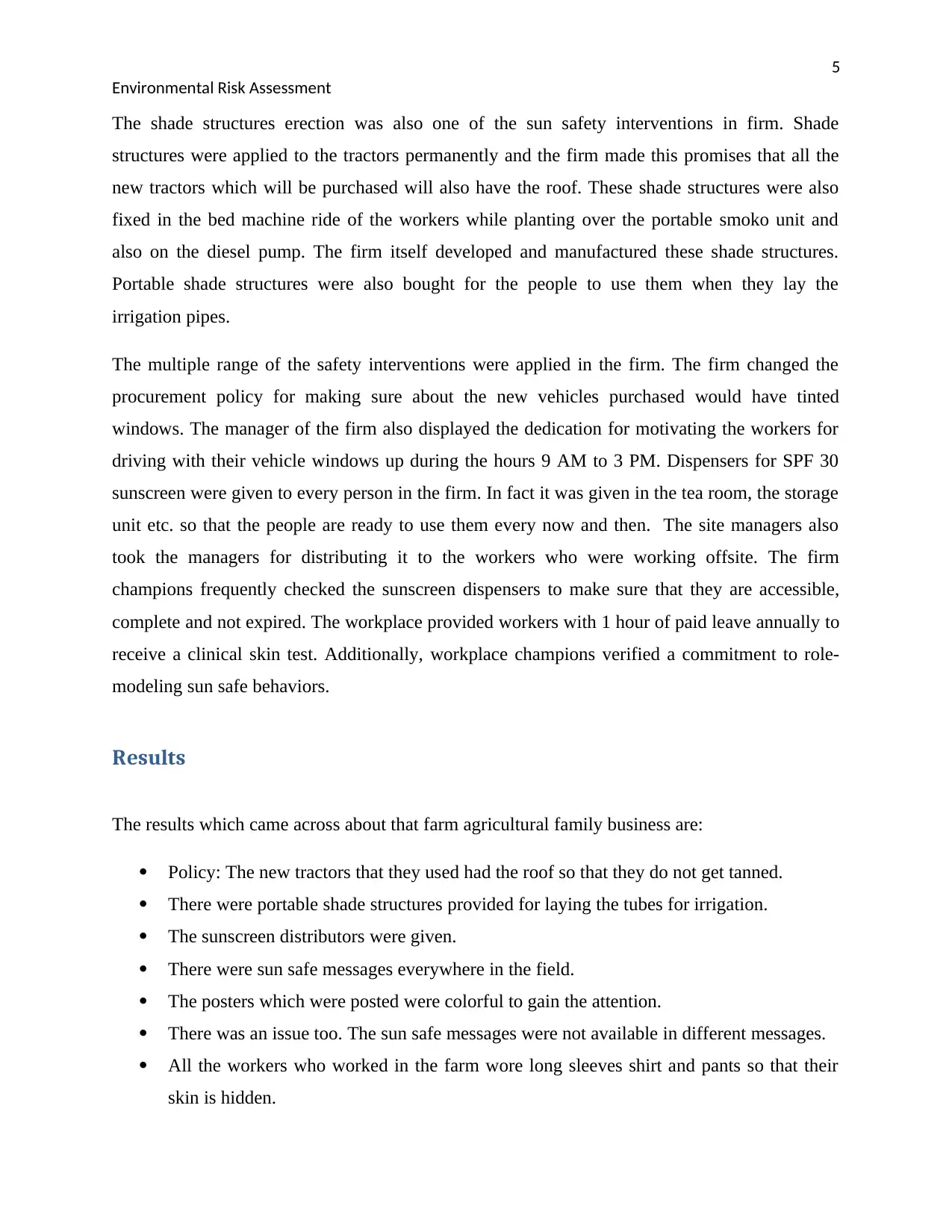
5
Environmental Risk Assessment
The shade structures erection was also one of the sun safety interventions in firm. Shade
structures were applied to the tractors permanently and the firm made this promises that all the
new tractors which will be purchased will also have the roof. These shade structures were also
fixed in the bed machine ride of the workers while planting over the portable smoko unit and
also on the diesel pump. The firm itself developed and manufactured these shade structures.
Portable shade structures were also bought for the people to use them when they lay the
irrigation pipes.
The multiple range of the safety interventions were applied in the firm. The firm changed the
procurement policy for making sure about the new vehicles purchased would have tinted
windows. The manager of the firm also displayed the dedication for motivating the workers for
driving with their vehicle windows up during the hours 9 AM to 3 PM. Dispensers for SPF 30
sunscreen were given to every person in the firm. In fact it was given in the tea room, the storage
unit etc. so that the people are ready to use them every now and then. The site managers also
took the managers for distributing it to the workers who were working offsite. The firm
champions frequently checked the sunscreen dispensers to make sure that they are accessible,
complete and not expired. The workplace provided workers with 1 hour of paid leave annually to
receive a clinical skin test. Additionally, workplace champions verified a commitment to role-
modeling sun safe behaviors.
Results
The results which came across about that farm agricultural family business are:
Policy: The new tractors that they used had the roof so that they do not get tanned.
There were portable shade structures provided for laying the tubes for irrigation.
The sunscreen distributors were given.
There were sun safe messages everywhere in the field.
The posters which were posted were colorful to gain the attention.
There was an issue too. The sun safe messages were not available in different messages.
All the workers who worked in the farm wore long sleeves shirt and pants so that their
skin is hidden.
Environmental Risk Assessment
The shade structures erection was also one of the sun safety interventions in firm. Shade
structures were applied to the tractors permanently and the firm made this promises that all the
new tractors which will be purchased will also have the roof. These shade structures were also
fixed in the bed machine ride of the workers while planting over the portable smoko unit and
also on the diesel pump. The firm itself developed and manufactured these shade structures.
Portable shade structures were also bought for the people to use them when they lay the
irrigation pipes.
The multiple range of the safety interventions were applied in the firm. The firm changed the
procurement policy for making sure about the new vehicles purchased would have tinted
windows. The manager of the firm also displayed the dedication for motivating the workers for
driving with their vehicle windows up during the hours 9 AM to 3 PM. Dispensers for SPF 30
sunscreen were given to every person in the firm. In fact it was given in the tea room, the storage
unit etc. so that the people are ready to use them every now and then. The site managers also
took the managers for distributing it to the workers who were working offsite. The firm
champions frequently checked the sunscreen dispensers to make sure that they are accessible,
complete and not expired. The workplace provided workers with 1 hour of paid leave annually to
receive a clinical skin test. Additionally, workplace champions verified a commitment to role-
modeling sun safe behaviors.
Results
The results which came across about that farm agricultural family business are:
Policy: The new tractors that they used had the roof so that they do not get tanned.
There were portable shade structures provided for laying the tubes for irrigation.
The sunscreen distributors were given.
There were sun safe messages everywhere in the field.
The posters which were posted were colorful to gain the attention.
There was an issue too. The sun safe messages were not available in different messages.
All the workers who worked in the farm wore long sleeves shirt and pants so that their
skin is hidden.
⊘ This is a preview!⊘
Do you want full access?
Subscribe today to unlock all pages.

Trusted by 1+ million students worldwide
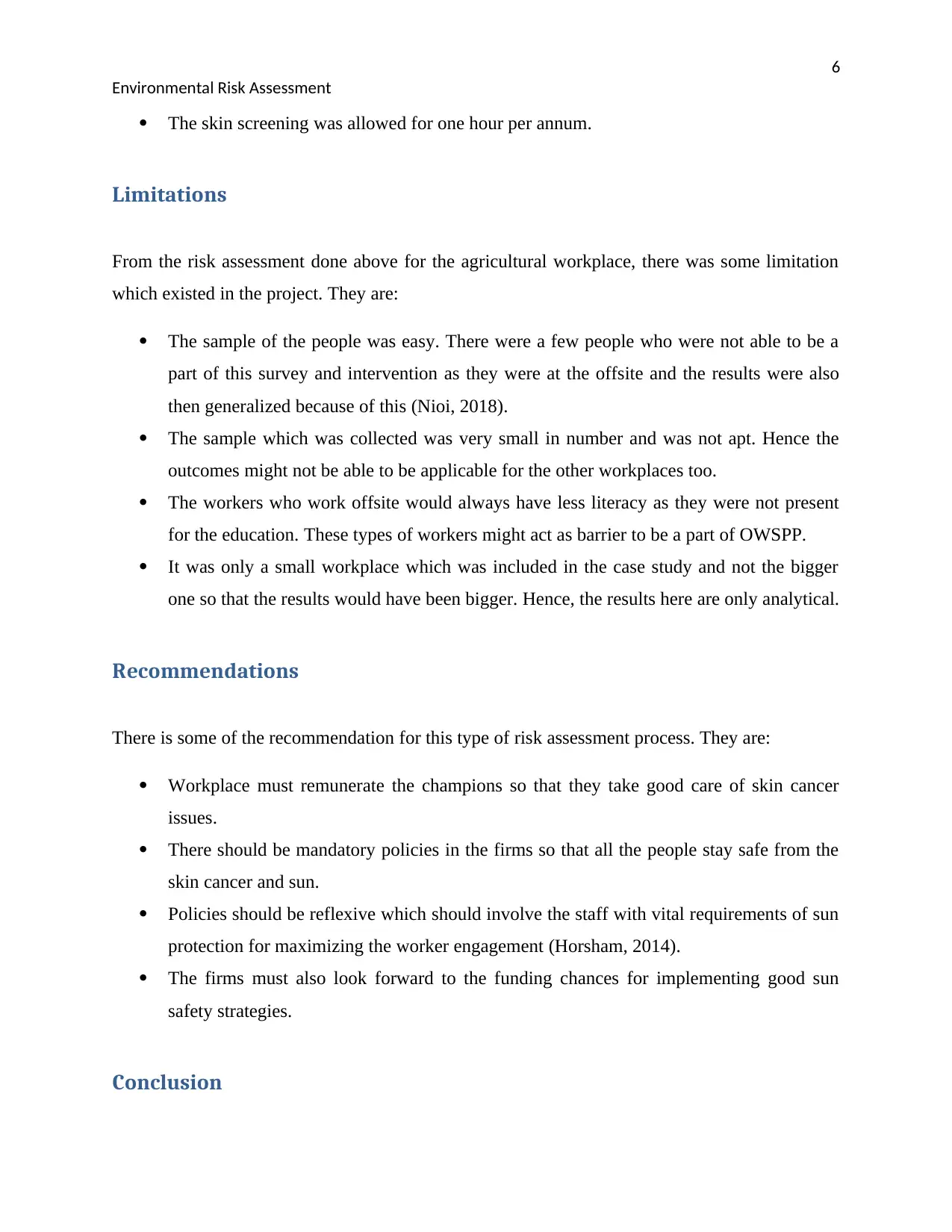
6
Environmental Risk Assessment
The skin screening was allowed for one hour per annum.
Limitations
From the risk assessment done above for the agricultural workplace, there was some limitation
which existed in the project. They are:
The sample of the people was easy. There were a few people who were not able to be a
part of this survey and intervention as they were at the offsite and the results were also
then generalized because of this (Nioi, 2018).
The sample which was collected was very small in number and was not apt. Hence the
outcomes might not be able to be applicable for the other workplaces too.
The workers who work offsite would always have less literacy as they were not present
for the education. These types of workers might act as barrier to be a part of OWSPP.
It was only a small workplace which was included in the case study and not the bigger
one so that the results would have been bigger. Hence, the results here are only analytical.
Recommendations
There is some of the recommendation for this type of risk assessment process. They are:
Workplace must remunerate the champions so that they take good care of skin cancer
issues.
There should be mandatory policies in the firms so that all the people stay safe from the
skin cancer and sun.
Policies should be reflexive which should involve the staff with vital requirements of sun
protection for maximizing the worker engagement (Horsham, 2014).
The firms must also look forward to the funding chances for implementing good sun
safety strategies.
Conclusion
Environmental Risk Assessment
The skin screening was allowed for one hour per annum.
Limitations
From the risk assessment done above for the agricultural workplace, there was some limitation
which existed in the project. They are:
The sample of the people was easy. There were a few people who were not able to be a
part of this survey and intervention as they were at the offsite and the results were also
then generalized because of this (Nioi, 2018).
The sample which was collected was very small in number and was not apt. Hence the
outcomes might not be able to be applicable for the other workplaces too.
The workers who work offsite would always have less literacy as they were not present
for the education. These types of workers might act as barrier to be a part of OWSPP.
It was only a small workplace which was included in the case study and not the bigger
one so that the results would have been bigger. Hence, the results here are only analytical.
Recommendations
There is some of the recommendation for this type of risk assessment process. They are:
Workplace must remunerate the champions so that they take good care of skin cancer
issues.
There should be mandatory policies in the firms so that all the people stay safe from the
skin cancer and sun.
Policies should be reflexive which should involve the staff with vital requirements of sun
protection for maximizing the worker engagement (Horsham, 2014).
The firms must also look forward to the funding chances for implementing good sun
safety strategies.
Conclusion
Paraphrase This Document
Need a fresh take? Get an instant paraphrase of this document with our AI Paraphraser
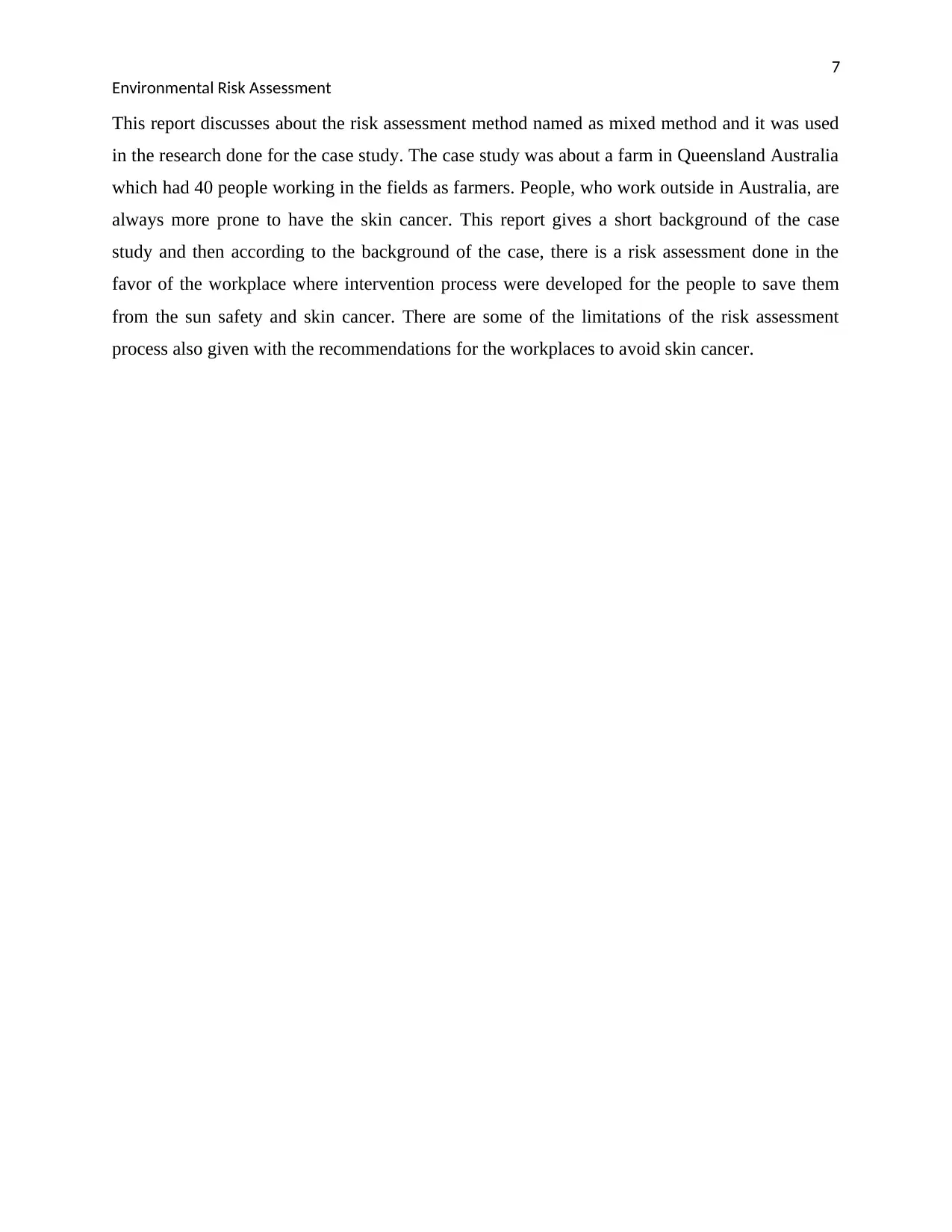
7
Environmental Risk Assessment
This report discusses about the risk assessment method named as mixed method and it was used
in the research done for the case study. The case study was about a farm in Queensland Australia
which had 40 people working in the fields as farmers. People, who work outside in Australia, are
always more prone to have the skin cancer. This report gives a short background of the case
study and then according to the background of the case, there is a risk assessment done in the
favor of the workplace where intervention process were developed for the people to save them
from the sun safety and skin cancer. There are some of the limitations of the risk assessment
process also given with the recommendations for the workplaces to avoid skin cancer.
Environmental Risk Assessment
This report discusses about the risk assessment method named as mixed method and it was used
in the research done for the case study. The case study was about a farm in Queensland Australia
which had 40 people working in the fields as farmers. People, who work outside in Australia, are
always more prone to have the skin cancer. This report gives a short background of the case
study and then according to the background of the case, there is a risk assessment done in the
favor of the workplace where intervention process were developed for the people to save them
from the sun safety and skin cancer. There are some of the limitations of the risk assessment
process also given with the recommendations for the workplaces to avoid skin cancer.
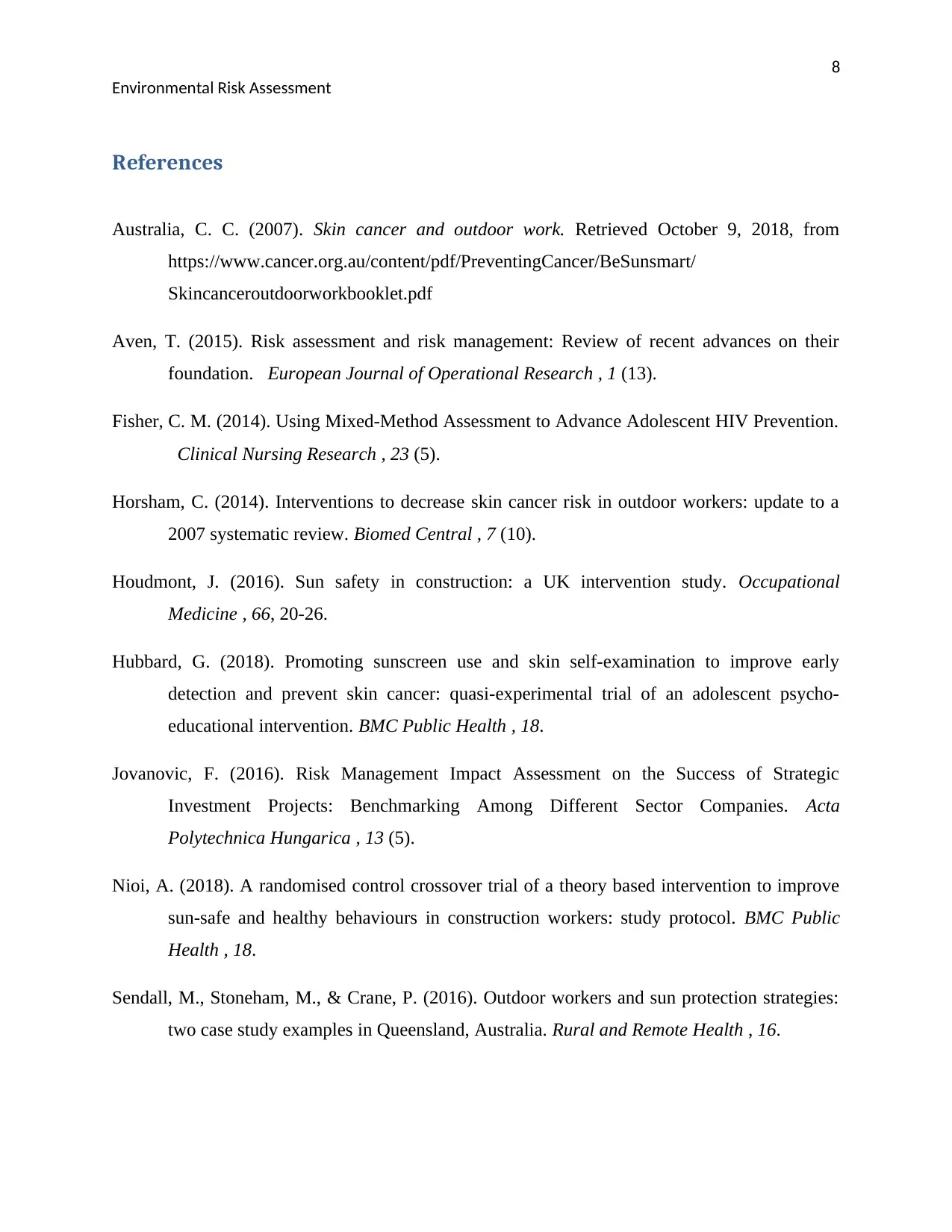
8
Environmental Risk Assessment
References
Australia, C. C. (2007). Skin cancer and outdoor work. Retrieved October 9, 2018, from
https://www.cancer.org.au/content/pdf/PreventingCancer/BeSunsmart/
Skincanceroutdoorworkbooklet.pdf
Aven, T. (2015). Risk assessment and risk management: Review of recent advances on their
foundation. European Journal of Operational Research , 1 (13).
Fisher, C. M. (2014). Using Mixed-Method Assessment to Advance Adolescent HIV Prevention.
Clinical Nursing Research , 23 (5).
Horsham, C. (2014). Interventions to decrease skin cancer risk in outdoor workers: update to a
2007 systematic review. Biomed Central , 7 (10).
Houdmont, J. (2016). Sun safety in construction: a UK intervention study. Occupational
Medicine , 66, 20-26.
Hubbard, G. (2018). Promoting sunscreen use and skin self-examination to improve early
detection and prevent skin cancer: quasi-experimental trial of an adolescent psycho-
educational intervention. BMC Public Health , 18.
Jovanovic, F. (2016). Risk Management Impact Assessment on the Success of Strategic
Investment Projects: Benchmarking Among Different Sector Companies. Acta
Polytechnica Hungarica , 13 (5).
Nioi, A. (2018). A randomised control crossover trial of a theory based intervention to improve
sun-safe and healthy behaviours in construction workers: study protocol. BMC Public
Health , 18.
Sendall, M., Stoneham, M., & Crane, P. (2016). Outdoor workers and sun protection strategies:
two case study examples in Queensland, Australia. Rural and Remote Health , 16.
Environmental Risk Assessment
References
Australia, C. C. (2007). Skin cancer and outdoor work. Retrieved October 9, 2018, from
https://www.cancer.org.au/content/pdf/PreventingCancer/BeSunsmart/
Skincanceroutdoorworkbooklet.pdf
Aven, T. (2015). Risk assessment and risk management: Review of recent advances on their
foundation. European Journal of Operational Research , 1 (13).
Fisher, C. M. (2014). Using Mixed-Method Assessment to Advance Adolescent HIV Prevention.
Clinical Nursing Research , 23 (5).
Horsham, C. (2014). Interventions to decrease skin cancer risk in outdoor workers: update to a
2007 systematic review. Biomed Central , 7 (10).
Houdmont, J. (2016). Sun safety in construction: a UK intervention study. Occupational
Medicine , 66, 20-26.
Hubbard, G. (2018). Promoting sunscreen use and skin self-examination to improve early
detection and prevent skin cancer: quasi-experimental trial of an adolescent psycho-
educational intervention. BMC Public Health , 18.
Jovanovic, F. (2016). Risk Management Impact Assessment on the Success of Strategic
Investment Projects: Benchmarking Among Different Sector Companies. Acta
Polytechnica Hungarica , 13 (5).
Nioi, A. (2018). A randomised control crossover trial of a theory based intervention to improve
sun-safe and healthy behaviours in construction workers: study protocol. BMC Public
Health , 18.
Sendall, M., Stoneham, M., & Crane, P. (2016). Outdoor workers and sun protection strategies:
two case study examples in Queensland, Australia. Rural and Remote Health , 16.
⊘ This is a preview!⊘
Do you want full access?
Subscribe today to unlock all pages.

Trusted by 1+ million students worldwide
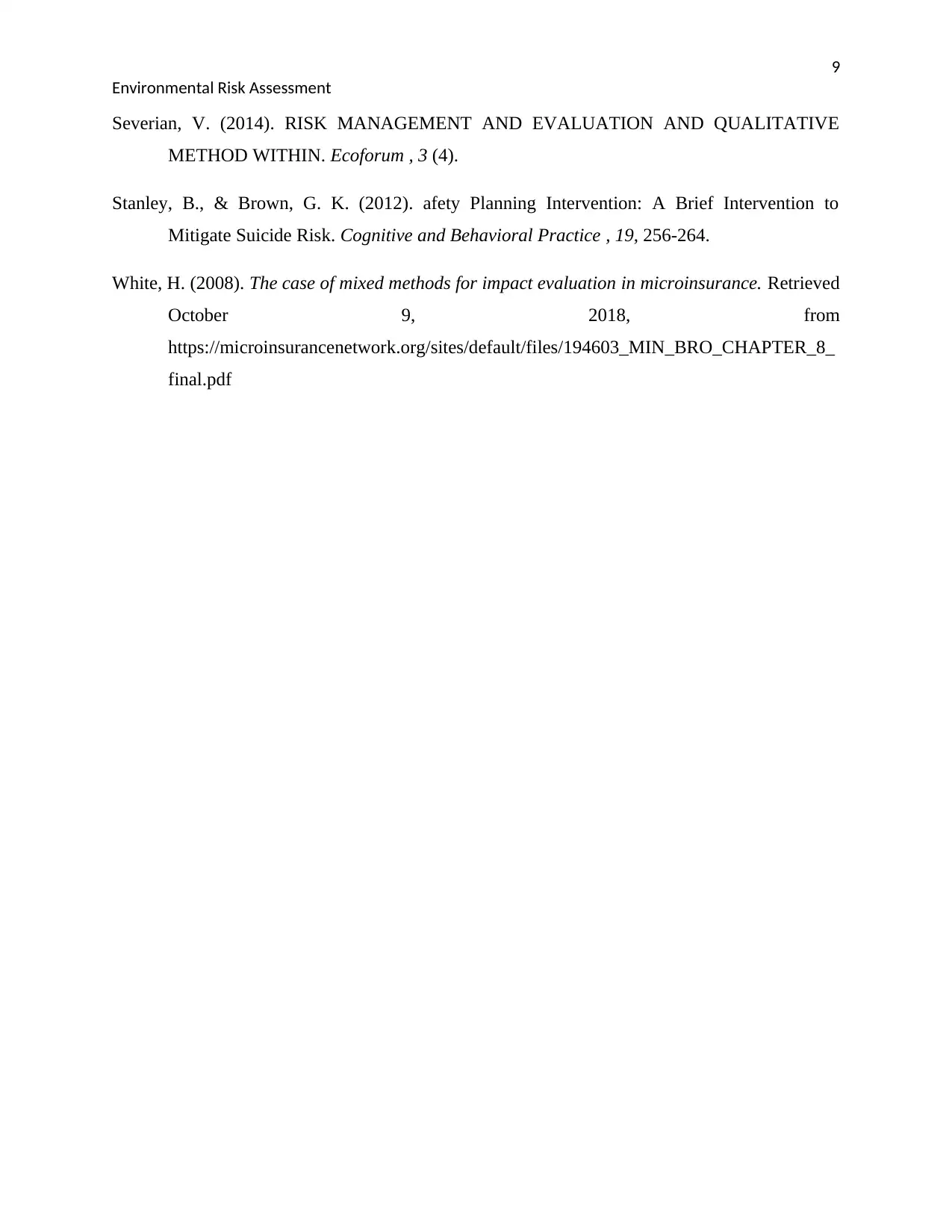
9
Environmental Risk Assessment
Severian, V. (2014). RISK MANAGEMENT AND EVALUATION AND QUALITATIVE
METHOD WITHIN. Ecoforum , 3 (4).
Stanley, B., & Brown, G. K. (2012). afety Planning Intervention: A Brief Intervention to
Mitigate Suicide Risk. Cognitive and Behavioral Practice , 19, 256-264.
White, H. (2008). The case of mixed methods for impact evaluation in microinsurance. Retrieved
October 9, 2018, from
https://microinsurancenetwork.org/sites/default/files/194603_MIN_BRO_CHAPTER_8_
final.pdf
Environmental Risk Assessment
Severian, V. (2014). RISK MANAGEMENT AND EVALUATION AND QUALITATIVE
METHOD WITHIN. Ecoforum , 3 (4).
Stanley, B., & Brown, G. K. (2012). afety Planning Intervention: A Brief Intervention to
Mitigate Suicide Risk. Cognitive and Behavioral Practice , 19, 256-264.
White, H. (2008). The case of mixed methods for impact evaluation in microinsurance. Retrieved
October 9, 2018, from
https://microinsurancenetwork.org/sites/default/files/194603_MIN_BRO_CHAPTER_8_
final.pdf
1 out of 10
Related Documents
Your All-in-One AI-Powered Toolkit for Academic Success.
+13062052269
info@desklib.com
Available 24*7 on WhatsApp / Email
![[object Object]](/_next/static/media/star-bottom.7253800d.svg)
Unlock your academic potential
Copyright © 2020–2025 A2Z Services. All Rights Reserved. Developed and managed by ZUCOL.



